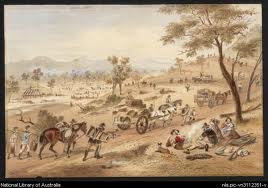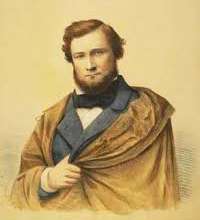The colonial authorities of Victoria faced a disastrous financial crisis in the 1850s. In spite of the wealth from gold mining, 1853 imports into Victoria reached £15,840,000, were substantially greater than exports, £11,060,000. The situation worsened in 1854, with imports exceeding exports by £5,880,000. The merchants objected to import duties because it would have increased the price of goods and made them more difficult to sell. There was a growing volume of unsold goods & the merchants were not prepared to make a tariff impost law against their interests.
In fact, by 1852 they reduced the number of items subject to import duties from 160 to 5. The other force on the Victorian Legislative Council was the pastoralists/squatters who were able to reduce the stock tax from threepence to twopence a head for sheep.
Because the Legislative Council did not solve the problem of matching expenditure with income the Victorian colony consequently faced the crisis of bankruptcy. By 1854 the Government in Victoria had a deficit of £1,085,896. Governor Hotham demanded that the sum of £4,801,992 be collected in tax for the year 1855 of which £1,860,830 was allotted to cover the costs of the extensive public works.
Because the 3 possible sources of large scale revenue, customs (on imported goods), land (tax on squatters’ leases) and gold (export duty) were not a possibility as far as the merchant and pastoralist controlled Legislative Council were concerned, the miners were targeted for the expense of balancing the budget.

Being the largest class of the community, the diggers were paying in direct taxation more than a half million pounds, whereas the great landholders and wool producers were paying only 20,000 pounds. Hotham initially wanted the miner’s fee to be increased from 30 shillings to three pounds per month. But the Legislative Council cautioned that this might well inflame the miners into full revolt!
Undaunted the miners had agitated for the reduction of license fees, the right to vote and purchase land. Agitation for these demands commenced with the Forest Creek Monster Meeting of December 1851 and included the formation of the Anti-Gold License Association at nearby Bendigo in 1853.
Consequently, concessions were made to the miners and the monthly mining license fee was reduced from thirty shillings to £1/10 shillings or a yearly license of £8. The diggers considered this fee also exorbitant, because in 1851 a squatter could buy twenty square miles of land from the Victorian government for the same amount of £1/10 shillings.
Nevertheless, civil disobedience and protests in Ballarat began to grow as the burden of increased taxation was placed on the diggers and resulted in numerous injustices from the police and troopers who carried out abusive ‘license hunts’.

The problem of the Government bankruptcy was aggravated by the increasing refusal of the diggers to pay their license fees. Hotham demanded they should obey the law and pay their license fees therefore assist his budget problems. He ordered twice weekly ‘license hunts’ to achieve his needed tax collection. The increased pressure on the diggers was a result of the expanding colonial Victorian deficit and the unwillingness of the big monopolists (pastoralists/squatters) to pay tax.







